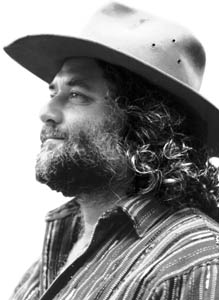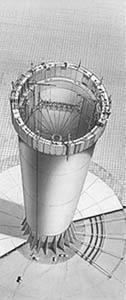![[Metroactive Features]](/gifs/feat468.gif)
[ Features Index | Santa Cruz | Metroactive Home | Archives ]
Extreme Green
Crusading, visionary and sometimes downright eccentric greens are fighting to temper our dependency on foreign fossil fuels--one potato at a time
By Mike Connor
"The two most abundant elements in the universe are hydrogen and stupidity; hydrogen can easily be produced in a controllable form from water; and stupidity will either misapply it ... or just plain keep it suppressed ..."
A heavy metal guitarist named Carl Cella doled out the preceding bit of wisdom back in 1995 in an article about how to run a car on hydrogen extracted from water. He included specific, hand-drawn schematics that looked like they might actually work, but I just don't trust "the madman behind the heavy metal band Rampage" enough to install a homemade reactor in my trunk ... yet.
Fortunately, headbangers aren't the only ones getting lean, mean and green. There's a gaggle of supersmart greenies developing all kinds of cheap, clean sources of energy that have nothing to do with fossil fuels, and that are often much safer than driving around town with a homemade reactor in your trunk.
Meanwhile, the Bush administration's credibility on environmental issues is going up in smoke. The San Francisco Chronicle recently reported that the administration, in an unprecedented move, wants to take away the power of individual states to make their own environmental regulations, superseding them with new--and weaker--federal guidelines. What that means is that some of the stricter controls that California has adopted regarding everything from air quality to clean drinking water are threatened.
Granted, the regulations aren't directly impeding the progress of green technology, but yet another backward stride toward a dirtier environment doesn't say much for the administration's leadership role in a move towards cleaner, more efficient sources of energy--plus it just sucks.
In the face of this horrendous knuckle-dragging leadership at the national level, greensters are nevertheless pushing forward with all manner of kick-ass environmentally friendly technology. Even conservatives are waking up and smelling the biodiesel. A columnist for The New York Times, Thomas L. Friedman, recently exhorted President Bush to "embark on a Manhattan project to increase fuel efficiency and slash the cost of alternative energy sources to reduce our dependence on foreign oil. Yes, it will take time, but gradually it will make us more secure as a nation, it will shrink the price of oil."
All true, but as conservative as he is, Friedman doesn't have the luxury of sharing with you all the groovy pie-in-the-sky possibilities of green energy, most of which already exist today. We're talking cars driven around powered by algae, booze, vegetable oil or just plain old water. We're talking about mushrooms to save the world. And yeah, we're talking about plugging a toaster oven--or a power plant, for that matter--right into the giant capacitor we call Earth.
Sound impossible? Tell that to a man who carved out his place in history playing with lightning.
A Short Tribute to NiKola Tesla
No, I'm not talking about Thomas Edison, although the Serbian inventor extraordinaire Nikola Tesla did work with Edison as a gofer for a while. But while Edison fathered direct current (DC), Tesla invented the alternating current (AC) that has since become the basis of power as we know it. He also invented radio, and stories of a high-powered death ray with which he accidentally incinerated a huge chunk of forest in Siberia, and of a microwave beam which he used to send Nazi submarines into another dimension, are the stuff of legend and are great fodder for fascinating conspiracy theories. But he is most famous for the visually stunning Tesla coil, the largest of which reportedly created thunder audible from 15 miles away, and discharged 12-million-volt, 100-foot-long electrical sparks. His dream was to create a machine that would produce unlimited amounts of energy, which could be transmitted wirelessly through the earth. Despite many attempts, Tesla never got the funding he needed to give it a go. Even still, he's the unsung hero of a legion of science geeks and conspiracy theorists who believe that Tesla held the key to unlimited free energy.
But without further paranoid or sentimental ado, here are some kick-ass projects in the works that would make Nicola Tesla proud. It is by no means a comprehensive list, but it is a cool one, so enjoy.
Runnin' on Moonshine
WHAT IT IS: If local ecologist and alcohol guru "Farmer" David Blume had things his way, we'd all be driving around with a belly full of brandy--a car belly full of brandy, that is. Some of the earliest combustion engines ran on alcohol, which is virtually pollution-free when it's burned. And with all the subsidized farming surpluses in the Midwest, it's obvious that there's a gold mine of potential fuel (corn). Plus, Blume points out that the by-product of alcohol production from corn is a highly concentrated and nutritious feed with which we can fatten up our livestock. Sure, vegetarianism is better for the planet, but even still, the question still remains: Would you like fries with that?
HOW IT WORKS: Booze-powered engines function like gasoline-powered engines, with minor recalibrations to the air/fuel mixture. Older cars can be converted relatively easily (Blume says less than $1,000), but the newer, fuel-injected cars take some doing.
French-Fried Fuel
WHAT IT IS: Biodiesel fuel is about 80 percent vegetable oil, cut with methanol and a dash of lye. Ray Newkirk, local contractor and editor of the Green Press, makes his own biodiesel with used oil from the Saturn Cafe and Malabar. There's no place nearby that you can simply buy biodiesel, because a seller's permit requires mountains of paperwork and regulation. But Santa Cruz biodiesel aficionados make it work by forming co-ops, which aren't regulated. And the feds are foiled again! For now.
HOW IT WORKS: The finished product can go right into any diesel engine. The only modification required is to swap out the old rubber components in older cars with stainless steel or special noncorrosive rubber tubes. The emissions are 90 percent cleaner than standard diesel, and smell like barbecued potatoes. In the event that your local restaurant can't deliver the greasy goods for a while, fear not: Biodiesel is 100 percent compatible with standard diesel, meaning that the engine will run fine on any mixture of the two types of fuel. For more info, Newkirk recommends reading From the Fryer to the Fuel Tank by Joshua Tickell, which many consider to be the bible of biodiesel.
The Solar Chimney Power Plant
WHAT IT IS: As you read this, a company called Enviromission Ltd. is searching for a suitable site in Australia on which they plan to erect the highest man-made structure on earth. Simple in its design, the solar chimney is basically just a 3,290-foot-tall greenhouse (nearly 2.5 times as tall as the Sears Tower in Chicago), with a circular base that covers six square miles.
HOW IT WORKS: As the sun shines into the dark, insulated interior, the giant tube collects heat. The hot air rushes ever upward, creating a constant flow of wind that propels wind turbines throughout the tube. This puppy will provide around 500 gigawatt-hours of electricity per year, which can power roughly 200,000 homes. But it sucks because the extra heat captured in the tube actually contributes to global warming (although there are zero greenhouse gas emissions). Smaller-scale models have also proved to be successful, but the concept is most efficient when it's realized on a biblical scale. Some people find the gigantic structures off-putting, but I think those people are just not imagining the entire tube tinted an attractive teal, with cute little swirly designs etched into it.
Guerrilla Solar
WHAT IT IS: OK, so you've got your little solar-powered photovoltaic array in your backyard, but the local power company is dragging its feet when it's time for your refund. For some hardcore solarites, that's their cue to go guerrilla.
HOW IT WORKS: "Net metering" is a logical concept wherein people pumping electricity back into the grid get credit from the electric company for their contributions. According to some solar users, the process is a nightmare of red tape. But with a little illegal finagling, solar users can have their meters spinning backwards in no time! Not that we advocate that sort of thing.
Mushroom Bioremediation
WHAT IT IS: Mushrooms to save the world! According to "renaissance mycologist" Paul Stamets, mushrooms aren't just houses for Smurfs anymore. Besides being a tasty appetizer, some fungi can assist in the decomposition of hazardous waste materials.
HOW IT WORKS: In a recent Salon article, Linda Baker wrote, "In collaboration with several public and private agencies, [Stamets] is pioneering the use of 'mycoremediation' and 'mycofiltration' technologies. These involve the cultivation of mushrooms to clean up toxic waste sites, improve ecological and human health, and in a particularly timely bit of experimentation, break down chemical warfare agents possessed by Saddam Hussein." Just don't expect them to taste good on pizza.
Gusts of Improvement
WHAT IT IS: Anyone who's driven over the Altamont Pass on the 580 east out of S.F. knows what a wind farm looks like: thousands of wind turbines spinning in unison, hypnotizing vulnerable drivers to do their every bidding.
HOW IT WORKS: The wind (caused by the sun heating the Earth's surface unevenly) generates electricity by turning the turbines of giant windmills. Wind turbine technology has improved in leaps and bounds within the last five years, with some oil companies sinking millions of dollars into turbine research. Over the next 10 years, Exxon-Mobile alone will donate $100 million to a Stanford renewable energy research project. But before we all start wetting our pants, let's remember that the same company will spend approximately $100 billion on oil development projects in the next 10 years.
Tidal Power
WHAT IT IS: Simply speaking, since the tides are powered by the gravitational pull of the moon, then capturing the natural energy of the tides is like (indirectly) harnessing the power of the moon--and I totally wrote a poem about that once! Although it involved a loincloth and a flaming chariot, but still ... the point is that there are already plants in France and Canada that are making the moon their bitch.
HOW IT WORKS: The simplest and most common method is the ebb-generating system. Basically, it's just a dam built across a bay, which opens as the tide is coming in, and then closes and traps the accumulated water as the tide moves out. The trapped water then has no choice (sucka!) but to flow back out to sea through energy-generating turbines. It's a clean and simple concept, but it ain't cheap to build, and depending on local geography, the system can adversely affect shoreline ecosystems. Tidal fences and tidal turbines are less obtrusive, and similar to wind turbines in their design, acting like huge, underwater turn-styles to the passing water. All aboard! Except for some marine life, which may be "disrupted" into little pieces by the spinning blades (they're still working on that one).
Wave Goodbye to Energy Woes
WHAT IT IS: Surfers know all too well the awesome power of waves. Some may find a certain poetry in the thought that the same energy that pounded them face-first into the ocean floor can be used to power the portable massager used to soothe aching neck muscles the next day.
HOW IT WORKS: Oscillating water columns, which look a lot like a fireplace and chimney, are situated on the shoreline where the waves crash. The water of an incoming wave rushes into the base, and as the water runs back out, it creates a vacuum effect that draws air through a wind turbine in the chimney (can you say "gravity bong"?). The more friendly-named "salter ducks" are teardrop-shaped buoys anchored offshore, where they are rotated by passing swells to generate energy.
The Hydrogen Economy
WHAT IT IS: Proponents of the so-called "hydrogen economy" (not to be confused with hydrogen bombs, which involve all sorts of nasty nuclear reactions) dream of a time when the hydrogen derived from water will power the world. In a heartening bit of news, the world's first energy station featuring hydrogen and electricity co-production opened in Las Vegas, Nev., last month. And with enough luck at the tables, you just might need that hydrogen to fill up your brand new space shuttle.
HOW IT WORKS: When it's burned as fuel, hydrogen burns cleaner and more efficiently than gasoline. It's also much more dangerous to work with (see: the Hindenberg), but it can be used safely (see: most of the space shuttle flights). Pollution-free fuel cells aboard the shuttle produce on-board electricity by combining hydrogen with oxygen. Astronauts drink the only by-product, which just so happens to be water--perfect for making Tang! Ford and DaimlerChrysler expect to be mass-producing hydrogen-powered cars within five years.
Welcome to Civano
WHAT IT IS: If cookie-cutter housing is a reality that we have to face, at least communities like Civano in Tuscon, Ariz., are making an effort to stay green. Once you get past the weird Stepford Wives feel of overplanning on the website, the Civano model is actually quite commendable for the ant colony that it is.
HOW IT WORKS: Civano homes are designed to use 50 percent less energy than a typical home of the same size. And, simply stated, it's cheaper to get energy-saving materials and designs in bulk for the same reason that buffalo wings are cheaper to buy in a box of 500 from Costco, except without all the indigestion.
Algae Farts
WHAT IT IS: Spirulina is that highly nutritious algae that makes your Odwalla Superfood that funny greenish-blue color. It and other algae produce small amounts of hydrogen as they grow. And then some clever scientists at UC-Berkeley, in conjunction with the Department of Energy, discovered that if you starve it of sulfur and oxygen, it produces even more hydrogen, which can be used for fuel. And speaking of farts (methane gas), landfills produce large quantities of methane, which can be easily converted into hydrogen. Now if someone could only figure out how to capture my brother's farts after Thanksgiving, our energy woes will be over for good.
HOW IT WORKS: Metabolism au naturel! Except for the algae starvation part.
[ Santa Cruz | Metroactive Central | Archives ]
Copyright © Metro Publishing Inc. Maintained by Boulevards New Media.
![]()
 Local Ecologist: "Farmer" Dave Blume is the toast of alcohol-fuel proponents.
Local Ecologist: "Farmer" Dave Blume is the toast of alcohol-fuel proponents.

A Space Shuttle In Every Garage OK, not really, but its hydrogen-fuel formula is a greenie fave.
 Chim Chim Charoo: This is a solar chimney. It kicks your chimney's ass.
Chim Chim Charoo: This is a solar chimney. It kicks your chimney's ass.
From the December 18-24, 2002 issue of Metro Santa Cruz.